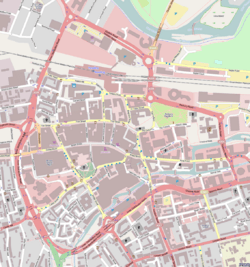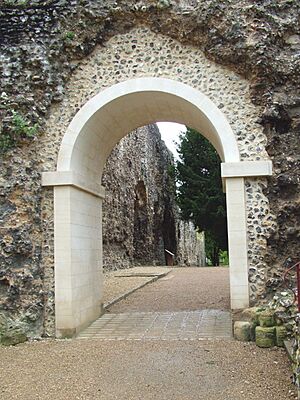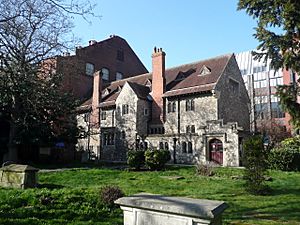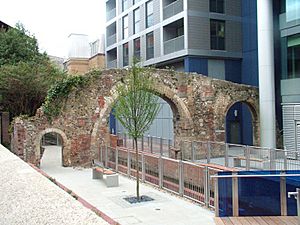Reading Abbey facts for kids
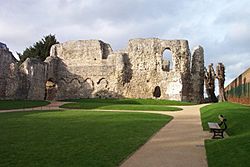
The chapter house, from the site of the monks' dormitory
|
|
| Monastery information | |
|---|---|
| Full name | The Abbey of Reading, dedicated to the Virgin and St John the Evangelist |
| Order | Cluniac |
| Established | 18 June 1121 |
| Disestablished | 1539 |
| Dedicated to | Mary, mother of Jesus John the Evangelist |
| People | |
| Founder(s) | Henry I of England |
| Important associated figures | Hugh Cook of Faringdon |
| Site | |
| Location | Reading, Berkshire, England |
| Coordinates | 51°27′22.85″N 0°57′54.31″W / 51.4563472°N 0.9650861°W |
| Visible remains | Inner rubble cores of the walls of the major buildings; gateway and hospitium intact. |
| Public access | Open daily |
Reading Abbey is a large, ruined monastery in the middle of Reading, a town in England. It was started by King Henry I in 1121. He built it to help his own soul and the souls of his family. In its best days, Reading Abbey was one of the biggest royal monasteries in Europe. Today, the nearby St James's Church continues some of the Abbey's traditions. This church is even partly built with stones from the old Abbey.
Reading Abbey was part of a big project called "Reading Abbey Revealed." This project cost £3 million. It helped fix the old ruins and the Abbey Gateway. The site reopened to the public on June 16, 2018. Along with fixing the buildings, new signs and exhibits were added. There is also a new gallery at Reading Museum.
The "Abbey Ward" of Reading Borough Council is named after Reading Abbey. The Abbey is located within this area. Today, HM Prison Reading is also on the Abbey's old land.
Contents
History of Reading Abbey
When was Reading Abbey founded?
King Henry I founded Reading Abbey in 1121. He gave the Abbey his land in Reading. He also gave land in other places like Cholsey and Leominster. Some land in Reading that belonged to another abbey was also moved to Reading Abbey.
Monks from Cluny Abbey in France helped start the Abbey. Monks from a priory (a smaller monastery) in Lewes also joined. The Abbey was dedicated to the Virgin Mary and St John the Evangelist. The first abbot (leader of the monks) was Hugh of Amiens in 1123. He later became an important archbishop.
Why was the Abbey built in Reading?
The Abbey was built on a gravel area between the River Kennet and the River Thames. This spot was good for travelers going to big cities in England. The rivers made it easy to transport goods. The Abbey had docks on the River Kennet. The Kennet also powered the Abbey's water mills. Many of these mills were on the Holy Brook, a special channel of the Kennet.
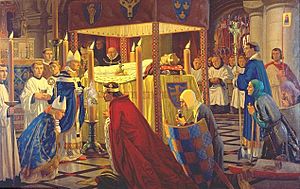
Who was buried at Reading Abbey?
When King Henry I died in 1135, his body was brought back to Reading. He was buried in front of the altar at the Abbey. The Abbey was not even finished yet. Other important people buried there included parts of Matilda of Scotland and Constance of York.
Why was Reading Abbey important?
Because kings supported it, Reading Abbey became a major pilgrimage site. It was one of the richest and most important religious places in medieval England. It owned land far away in places like Herefordshire and Scotland. The Abbey also had over 230 relics. One famous relic was the hand of St James. A shriveled hand was found in the ruins in 1786. It is now in a church in Marlow.
The song Sumer is icumen in was first written down at the Abbey around 1240. It is the oldest known six-part harmony from Britain. The original document is kept in the British Library.
Kings and other important people often visited Reading Abbey. King Henry III visited many times a year. The Abbey also hosted big events. These included a meeting between King Henry II and the Patriarch of Jerusalem in 1185. The wedding of John of Gaunt and Blanche of Lancaster happened there in 1359. A meeting of Parliament was held there in 1453.
What happened to Reading Abbey?
Most of the Abbey was destroyed in 1538. This happened during King Henry VIII's Dissolution of the Monasteries. This was when many monasteries in England were closed down. The last abbot, Hugh Faringdon, was found guilty of treason. He was executed in front of the Abbey Church. After this, people took many parts of the Abbey buildings. They removed lead, glass, and stones to use in other places.
About 20 years after the Abbey closed, Reading town council made a new town hall. They used the old refectory (dining hall) of the Abbey's hospitium (guest house). The lower part of this building was used by Reading School since 1486. For 200 years, this old building was Reading's town hall. But by the 1700s, it was falling apart. Between 1785 and 1786, the old hall was taken down. A new Reading Town Hall was built in its place. Around 1787, Henry Seymour Conway took many stones from the Abbey walls. He used them to build Conway's Bridge near Henley.
St James's Church and School were built on part of the Abbey site. This happened between 1837 and 1840. Reading Gaol (prison) was built in 1844. It was on the eastern part of the Abbey site. The rest of the Abbey site was sold to Reading Corporation. This created the Forbury Gardens, which opened in 1861.
Reading Abbey Ruins
What can you see at the Abbey ruins today?
The inner parts of the walls of many Abbey buildings still stand. Only small pieces of the Abbey Church are left. These include parts of the central tower and the transepts (side sections). To the south of the transept, you can see the remains of the vestry and the chapter house. You can also see the infirmary passage and the ground floor of the monks' dormitory and toilet block. The best-preserved ruins are those of the chapter house. It has a rounded end and three entrances. The ruins are protected as a Grade I listed building and a Scheduled monument.
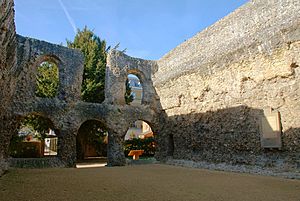
How were the Abbey ruins restored?
Over the years, the ruins were repaired in small ways. This led to them getting worse. In 2008, parts of the Abbey were closed to the public. Repair work started in 2009, but the whole site closed due to falling stones.
In 2010, the council thought repairs might cost £3 million. A detailed survey was done using 3D scans. This helped show how much work was needed. In 2011, plans for an £8 million project were announced. The goal was to create an "Abbey Quarter" cultural area. In 2014, the council got money from the Heritage Lottery Fund (HLF). More detailed plans were sent to the HLF in 2015.
A temporary roof was put on the Gateway in 2014. This helped the building dry out. The HLF gave a grant of £1.77 million in 2015. Reading Borough Council added £1.38 million. Work began in September 2016. The ruins reopened to the public on June 16, 2018.
What is the Hidden Abbey Project?
In 2014, historian Philippa Langley started the Hidden Abbey Project (HAP). She is known for finding the bones of King Richard III. This project aimed to study the Abbey grounds using ground-penetrating radar (GPR). This technology can see what is underground without digging.
The first GPR survey started in 2016. It focused on the Abbey Church and nearby areas. Early results showed some possible grave sites behind the main altar. These are east of where King Henry I's grave is thought to be. The survey also found things related to the Abbey's construction. No direct link to King Henry I's grave has been made from these findings alone.
Other Abbey Buildings
Besides the main Abbey ruins, other parts of the Abbey complex still exist.
Abbey Gateway
The Abbey's Inner Gateway is also called the Abbey Gateway. It is next to Reading Crown Court and Forbury Gardens. It is one of only two Abbey buildings that are still complete. It is a Grade I listed building. The Gateway showed the boundary between public areas and areas only for monks. Hugh Faringdon, the last abbot, was executed outside this Gateway in 1539.
The Gateway survived because it was used as the entrance to the abbot's home. This home became a royal palace after the Abbey closed. In the late 1700s, the Gateway was part of the Reading Ladies’ Boarding School. The famous writer Jane Austen attended this school.
The Gateway was heavily repaired after part of it fell during a storm in 1861. It was repaired again in 2010 after stones fell. It reopened in 2018. The room above the Gateway is now used by Reading Museum for school programs. People can walk and cycle through the arch below.
Hospitium of St John
The Abbey's hospitium (guest house for pilgrims) also still stands. It is known as the Hospitium of St. John and was founded in 1189. This building was the main part of a larger group of buildings. These buildings could hold 400 people. Much of the rest of this area is now where Reading Town Hall stands. Today, the surviving building is somewhat isolated. It is next to the main concert hall of Reading Town Hall. It also opens onto the churchyard of St Laurence's Church.
Abbey Mill and Holy Brook
Some parts of the old Abbey Mill can be seen next to the Holy Brook. This is at the south of the Abbey site. The water mill belonged to Reading Abbey. The monks are thought to have created the Holy Brook. This channel brought water to this mill and other mills owned by the Abbey. It also supplied water to the Abbey's fish ponds.
The Holy Brook is about 6 miles (10 km) long. It is mostly man-made. It flows out of the River Kennet near Theale. It passes just south of the Abbey and then returns to the River Kennet.
Open-Air Theatre and Performances
The ruins of Reading Abbey have a history of live performances. Over the years, the site has become known for open-air theatre.
In the late 1980s, a group called La Grande Bouche held a cabaret there. It featured music, performances, and food.
In 1994, a big event called "From the Ruins" took place. It was the final event for the "Art in Reading" (AIR) festival. Many local artists and performers were involved. It included music, dance, paintings, and poetry. The event ended with a show using puppets and fireworks. It told the story of Reading Abbey.
In 1995, the ruined South Transept was used for the first Abbey Ruins Open Air Shakespeare play. This was a partnership between MDM Productions, Progress Theatre, and Reading Borough Council. In 1996, the plays moved to the ruined chapter house. Since 1999, Progress Theatre has staged these plays. This yearly event grew into the "Reading Abbey Ruins Open Air Festival" in 2007. Because of the repairs, the festival could not be held in 2009 and 2010. It moved to the gardens of Caversham Court. "Shakespeare in the Ruins" returned to the Chapter House in July 2018 after the ruins reopened.
Abbots of Reading Abbey
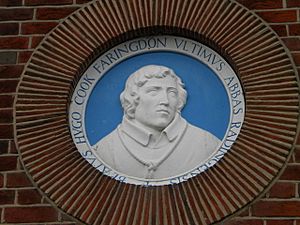
Reading Abbey was led by an abbot. There were 27 abbots between 1123 and 1539.
| Abbot | Years |
|---|---|
| Hugh I (of Amiens) | 1123–1130 |
| Anscher | 1130–1135 |
| Edward | 1136–1154 |
| Reginald | 1154–1158 |
| Roger | 1158–1165 |
| William I | 1165–1173 |
| Joseph | 1173–1186 |
| Hugh II | 1186–1199 |
| Helias | 1199–1213 |
| Simon | 1213–1226 |
| Adam (of Lathbury) | 1226–1238 |
| Richard I (of Chichester) | 1238–1262 |
| Richard II (of Reading, alias Bannister) | 1262–1269 |
| Robert (of Burgate) | 1269–1290 |
| William II (of Sutton) | 1290–1305 |
| Nicholas (of Whaplode) | 1305–1328 |
| John I (of Appleford) | 1328–1342 |
| Henry (of Appleford) | 1342–1361 |
| William III (of Dombleton) | 1361–1369 |
| John II (of Sutton) | 1369–1378 |
| Richard III (of Yately) | 1378–1409 |
| Thomas I (Earley) | 1409–1430 |
| Thomas II (Henley) | 1430–1445 |
| John II (Thorne I) | 1446–1486 |
| John III (Thorne II) | 1486–1519 |
| Thomas III (Worcester) | 1519–1520 |
| Hugh III (Cook, alias Faringdon) | 1520–1539 |
Notable Burials at Reading Abbey
Many important people were buried at Reading Abbey, including:
- King Henry I
- Anne de Beauchamp, 15th Countess of Warwick
- Constance of York
- Henry fitzGerold
- Matilda of Scotland
- Reginald de Dunstanville, 1st Earl of Cornwall
- Warin II fitzGerold
- William of Poitiers
Images for kids
-
The chapter house, from the site of the monks' dormitory
-
Burial of Henry I at Reading Abbey in 1136 painted by Harry Morley (1916)
-
The interior of the ruined chapter house
-
Abbey Mill across the Holy Brook
-
Plaque of Hugh III (Cook, alias Faringdon), the last Abbot
See also
 In Spanish: Abadía de Reading para niños
In Spanish: Abadía de Reading para niños


